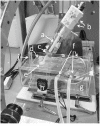Gel phantom study of a cryosurgical probe with a thermosiphon effect and liquid nitrogen-cooled aluminum thermal storage blocks
- PMID: 26412886
- PMCID: PMC4574327
Gel phantom study of a cryosurgical probe with a thermosiphon effect and liquid nitrogen-cooled aluminum thermal storage blocks
Abstract
Cryosurgery is a minimally invasive treatment for certain types of cancers. Argon-based cryosurgical devices are available at present, however a large compressed gas cylinder with the pressure of 300 atmospheres is needed. To overcome these drawbacks, we developed a new cryosurgical probe measuring about 50 cm in length with separate lumens inside for liquid and gaseous ethylene to be used as a thermosiphon and liquid nitrogen-cooled aluminum thermal storage blocks. The probe needle was 8 cm in length and 3 mm in outer diameter. To investigate the freezing capabilities of our new cryosurgical system we inserted the needle 5cm into a poly-acrylamide gel phantom warmed to 36.5 ℃. Thermal storage blocks made of aluminum, cooled at -196 ℃ in liquid nitrogen, were attached to the condenser of the probe and replaced with thermal storage blocks every 4 to 5 minutes to compensate for warming. We took digital camera images of the ice ball at the needle and measured the temperature in certain locations of the cryoprobe. Ice ball formation started at one minute after cooling. The sizes (longest diameter × minimum diameter) at 10, 20 and 30 minutes after the start of the procedure were 4.5×2.1, 4.5×3.1 and 4.6×3.7 cm, respectively. During the procedure the minimum temperature of the condenser was -85 ℃ and the needle was -65 ℃. This newly developed compact cryosurgical probe with thermosiphon effect and cooled thermal storage blocks created an ice ball that can be used for cryosurgery within 20 minutes.
Keywords: cryoablation; cryosurgery; cryotherapy; phantom study; thermosiphon.
Figures





References
-
- Harada J, Dohi M, Mogami T, Fukuda K, Miki K, Furuta N, Kishimoto K, Simizu T, Miyasaka K. Initial experience of percutaneous renal cryosurgery under the guidance of a horizontal open MRI system. Radiat Med, 2001; 19: 291–296. - PubMed
-
- Leibovici D, Zisman A, Siegel YI, Lindner A. Cryosurgical ablation for prostate cancer: preliminary results of a new advanced technique. Isr Med Assoc J, 2001; 3: 484–487. - PubMed
-
- Tozaki M, Fukuma E, Suzuki T, Hoshi K. Ultrasound-guided cryoablation of invasive ductal carcinoma inside the MR room. Magn Reson Med Sci, 2010; 9: 31–36. - PubMed
-
- Kawamura M, Izumi Y, Tsukada N, Asakura K, Sugiura H, Yashiro H, Nakano K, Nakatsuka S, Kuribayashi S, Kobayashi K. Percutaneous cryoablation of small pulmonary malignant tumors under computed tomographic guidance with local anesthesia for nonsurgical candidates. J Thorac Cardiovasc Surg, 2006; 131: 1007–1013. - PubMed
-
- Shimizu T, Sakuhara Y, Abo D, Hasegawa Y, Kodama Y, Endo H, Shirato H, Miyasaka K. Outcome of MR-guided percutaneous cryoablation for hepatocellular carcinoma. J Hepatobiliary Pancreat Surg, 2009; 16: 816–823. - PubMed
LinkOut - more resources
Full Text Sources
Other Literature Sources
